Bole
Barka ga ndako shafi bo pikka! [Welcome to the Bole Language Page!]
Background
BOLE is a language spoken in Yobe and Gombe States of northeastern Nigeria. About 250-300,000 people speak BOLE, making it among the largest languages in the region, perhaps surpassed only by its linguistic cousin HAUSA, the dominant language of all northern Nigeria and the sub-Saharan language with the most native speakers, and KANURI, the historically dominant language of northeastern Nigeria over the past few centuries. BOLE is a member of the Chadic Language family. Along with Hausa, Bole is a member of the West Branch of Chadic, but Bole and Hausa are not particularly closely related. The languages share a number typological features (similar consonant inventories, a two-tone system with downdrift, grammatical gender–though this has nearly disappeared as an active system in Bole, and similarities in sentence and phrasal word order), but they probably do not share more than 30% cognates in basic vocabulary.
The BOLE PEOPLE have played a prominent role in the pre-colonial, colonial, and post-independence periods of Nigeria. The EMIR OF FIKA (MOI PIKKA), the paramount figure in the traditional Bole ruling hierarchy, has, for a long period, occupied one of the preeminent traditional royal positions of northern Nigeria. Many individuals from the Bole community have risen to prominent positions in Nigerian politics, commerce, education, and media.
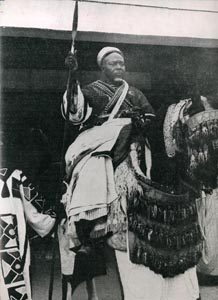
Moi Pikka, 1922-1976
(Nigeria Magazine, Dec. 1963)
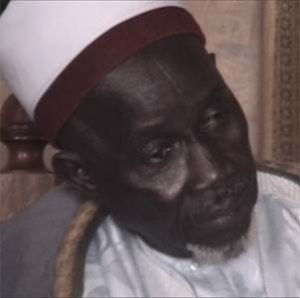
Moi Pikka, 1976-2009
Source of the Name
The source of the name “BOLE” is uncertain. This is not the term the people use for themselves or their language. One suggestion is that the term comes from the Bole phrase, “Bo le?“, which in Bole could mean either “Why?” (literally, “Because-of what?”) or “What language?” (literally, “Mouth-of what?”)–the word bo can mean either ‘because’ or ‘mouth’ and le means ‘what?’. It is not uncommon for a people or their language to get their “mainstream” name from a phrase that recurs in the language and that non-speakers hear and apply as an ethnic name without having any idea what it means. For example, Kanakuru is the widely used name for a group in northeastern Nigeria who call themselves “Dera”. “Kanakuru” in Dera means, “Good morning”! The table below shows the name of the Bole people and their language in Bole as well as Hausa and Kanuri, the dominant regional languages. As the table shows, both Hausa and Kanuri base their terms on the mysterious “Bole” root.
| BOLE | HAUSA | KANURI | |
| People | am Pikka (m), ani Pikka (f) anim Pikka = biya Pikka (pl) ‘one(s) of Fika’ |
Babole (m), Baboliya (f) Bolawa (pl) |
Bolea |
| Language | bo Pikka ‘mouth/language [of] Fika’ |
Bolanci | Bolea |
Research on Bole
The intention of this web site is to draw attention to an interesting and important language of Nigeria which is probably unknown to most people other than specialists. Information on this site derives from three grants from the US National Science Foundation:
“Bole Language: Grammar, Dictionary, and Texts” (08/01/1999-07/31/2001, #BCS9905180, Russell G. Schuh, Principal Investigator)
“The Chadic Languages of Yobe State, Nigeria” (12/01/2001-11/30/2004 with no-cost extension to 11/30/2005, #BCS0111289, Russell G. Schuh, Principal Investigator, Alhaji Maina Gimba, In-Country Director)
“Lexicon, Linguistic Structure, and Verbal Arts in Chadic Languages of Northeastern Nigeria” (08/15/2006-07/31/2009, #BCS0553222, Russell G. Schuh, Principal Investigator, Alhaji Maina Gimba, In-Country Director)
Directors of the project under the latter two grants are Russell G. Schuh, the Principal Investigator, and Alhaji Maina Gimba, the In-Country Director. Members of the Bole team are Malam Baba Ali and Madu Bah. Thanks go to HRH Moi Pikka, Alhaji Abali ibn Muhammadu, to members of the Fika Emirate Council, to the Fika Local Government Authority, to the Potiskum Local Government Authority, to the Fika Development Association (FIDA) for logistic, moral, and material support during summer 2000, and especially to Madu Liman and his family for indispensable logistic support.
Note on the name “Bole”
C.K. Meek (Tribal Studies in Northern Nigeria, Volume 2, page 288, Kegan Paul, 1931) suggests that the word Bole “would seem to embody a root bola = penis, or male, and the tribal name would thus, as so often in Africa, stand for ‘The Men'”. THIS IS COMPLETE NONSENSE, based on non-sequiturs such as noting that the Hausa word for ‘penis’ is “bura” (a word without known cognates in other Chadic languages) and that there is a northern Nigerian tribe called the Bura. One might just as well note the resemblance between Hausa “bura” and English “bear” in the sense of ‘give birth’! It is true that the autonyms for many African groups is “people” in the respective languages (though probably never “males” or “men”), but no African group identifies the word for “penis” with the word for “male, man”, much less “person” in general. The nonsensical nature of Meek’s suggestion is compounded by the fact “Bole” is NOT the autonym of the Bole people!



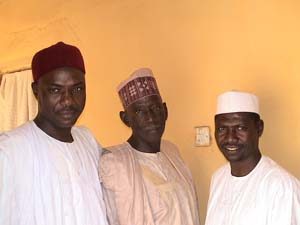
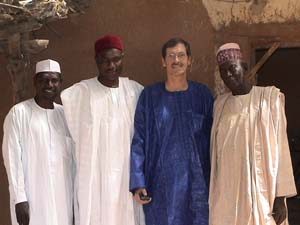
Location
BOLE is spoken in southern Yobe State and northern Gombe State in northeastern Nigeria.

Map credits: The map of Africa is adapted from a map available at http://www.miningco.com/.
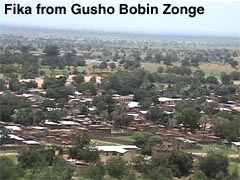
The main BOLE speaking area lies between POTISKUM, the largest city of Yobe State, and GOMBE, the largest city and capital of Gombe State. The largest town in the actual Bole speaking area is FIKA, located in the northern part of the Bole area. Fika is the traditional capital of the Bole people. The autonym of the Boles is Biya Pikka ‘People of Fika’, they call their language Bo Pikka ‘Language of Fika’, and the paramount traditional Bole ruler is Moi Pikka ‘Emir of Fika’. Fika was the home of the court of Moi Pikka until 1924, when the colonial administration moved his court to POTISKUM, which is on the main east-west road. The court of Moi Pikka remains there, and in part because of this, a large Bole speaking population lives in Potiskum town. Potiskum is actually at the nexus of the Ngizim and Karekare areas, though as is the case in every major town of northern Nigeria, the lingua franca of Potiskum is Hausa.
The linguistic neighbors of Bole on the north, west, and south are all Chadic languages of varying degrees of relatedness. Directly to the north and northwest is NGAMO, a close linguistic “sister” to Bole. A bit further to the north, in the area around Potiskum, are KAREKARE, a sort of “half-sister” and NGIZIM, a more distant “second cousin”. The area directly to the west is now mainly HAUSA-speaking, though there are or have been several poorly studied and perhaps now extinct linguistic sisters of Bole in this general area, such as Deno, Kubi, and Kirfi. To the south, in Gombe State is TANGALE, another “half-sister” of Bole, and to the southeast is TERA, a “third or fourth cousin” from the Biu-Mandara branch of Chadic. The area directly east of Bole was probably at one time occupied by speakers of other Biu-Mandara languages, but KANURI, which is not a Chadic language, has long since replaced them.
Linguistic Relatives
BOLE is a member of the Chadic language family. The Chadic family, in turn, is a member of the Afroasiatic phylum, i.e. at a very deep historical level, probably dating back 8-10,000 years, Bole shares a common ancestry with Arabic, Ancient Egyptian, Somali, and other languages of north Africa and the Middle East. Within the Chadic family, Bole is a member of the West Chadic subfamily, “A” branch, the same branch to which Hausa belongs.
- Place the cursor over the Afroasiatic tree to see the Chadic tree.
- Click to see the place of Bole within the West Chadic “A” branch.
Evidence for the Family Grouping of Bole
The most obvious evidence for asserting that languages are related to each other (i.e. that they descend from what was once a single language) is resemblances in everyday words. Every language has words for things common in daily life, such as terms for body parts, universal environmental features (e.g. sun, moon, water, fire), small numbers, universal actions and events (e.g. eat, drink, die, know, go), and so on. Depending on where languages are spoken, there will also be words that all languages of that area would need. In the West African savannah, some universally known objects would be dog, goat, sheep, fish, crocodile, python, guinea fowl, elephant, buffalo, baobab, various acacia trees, and other plants and animals typical of the area.
If we find that languages share a substantial number of similar words for such concepts, the only reasonable conclusion is that those languages must have inherited the words from a single ancestral language from which they all descend. Shifts in pronunciation and meaning have taken place in different ways in different communities after they dispersed from the home of their original community.
The table below presents the type of evidence we can use to demonstrate language relatedness.
- BOLE and HAUSA show many resemblances: we group them both in the “A” branch of West Chadic under the assumption of a relatively recent common ancestor
- BOLE and NGIZIM (and HAUSA and NGIZIM) show resemblances, but fewer and less similar than Bole and Hausa: we place Ngizim in the “B” group of West Chadic under the assumption that we have to go back in time to the original West Chadic language to find the ancestor that was common to Ngizim and the West Chadic “A” languages Bole and Hausa
- BOLE and KANURI show few, if any resemblances: Kanuri is not a Chadic language–it does not have a common ancestor with the Chadic languages
Words considered to “resemble” each other within a line are in red.
Note: @ = a “barred i” (written as a “shwa” in the standard orthography; a letter with an apostrophe after it = a “glottalized” sound
| BOLE | HAUSA | NGIZIM | KANURI | |
| two | bolou | biyu | shirin | indi |
| three | kunum | uku | kwan | yask@ |
| four | pod’d’o | hud’u | f@d’u | d@g@ |
| five | biyar | bad’i | vad’ | uwu |
| head | kai | koyi | ad’a | k@la |
| eye | ido | ido | da | shim |
| ear | kunne | kumo | agud’ | s@mo |
| nose | hanci | unti | t@n | k@nza |
| back | baya | boi | akau | ngawo |
| name | suna | sun | dlugun | su |
| sun | rana | poti | afa | k@ngal |
| moon | wata | tere | t@ra | k@mbal |
| oil | mai | mor | m@rak | k@ndag@ |
| water | ruwa | amma | am | nji |
| fish | kifi | kerwo | v@nakau | bunyi |
| python | mud’uwa | mid’i | kafa | kuluji |
| crocodile | kada | kadam | karam | karam |
| baobab | kuka | kushi | kuku | kuwa |
| Acacia nilotica | gabaruwa | jidimi | guvaru | k@ngar |
| eat | ci | ti | tau | bu |
| drink | sha | sa | sau | ya |
| do | yi | i | dlamu | di |
| return | maya | ma | katau | kalak |
| go out | fita | pata | v@ru | lug |
| die | mutu | motu | m@tu | nu |
| pour | zuba | jubbu | pau | tab |
Notes on Kanuri
The Kanuri citations are from Norbert Cyffer, English-Kanuri Dictionary, Köln:Rüdiger Köppe Verlag, 1994. The words for crocodile and baobab resemble the Chadic words because they ARE originally Chadic words borrowed into Kanuri. We know this because many Chadic languages that have had no contact with Kanuri also have similar words for these concepts. The ancestors of the people in today’s Kanuri-speaking area of Nigeria originally spoke Chadic languages. As the Kanuri took dominion over this area, people began speaking Kanuri at the expense of their original languages, but they apparently retained their old names for many species of flora and fauna, and those words came into the mainstream of Kanuri. Note that Ngizim has reborrowed the original Chadic root back from Kanuri! There are no waterways in Ngizim country that would support crocodiles, so this was probably an “exotic” creature to the Ngizims, who had no native name for it.
Greetings
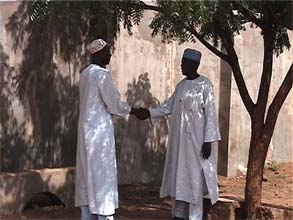 The movie below lets you hear some typical Bole greeting exchanges. You need QuickTime to view and play this movie.
The movie below lets you hear some typical Bole greeting exchanges. You need QuickTime to view and play this movie.
Sounds
The movie below is a narration in Bole of a cartoon strip featuring a character, Sauna, that appeared in Hausa publications in the 1950’s. Download transcript and translation.
Verbal Arts
This page provides downloadable files of Bole tales and other traditional verbal arts in Bole with line by line English translations. Sound files are available for some by request.
- The First Publications in Bole (publications from the NORLA)
- Traditional customs of marriage and birth (2002)
- Dindi Bo Pikka, Yaka (folktales by a storyteller in from Potiskum, Yobe State, 2000)
- Dindi Bo Pikka, Yagana Amma Mazawun (folktales by a storyteller from Mazawun, Yobe State, 2003)
- Komno Bo Bolewa (proverbs, riddles, tongue twisters, superstitions, and songs, 2004)
- Labar ga Komno Bo Bole (original prose, customs, tongue twisters, superstitions, 2007)
- Aru Bo Bole (bole songs, 2009)
- Stories and other texts from Fika Secondary School (2000)
- Miscellaneous other stories and narratives
The First Publications in Bole
The first publications in Bole were three small books that were published the the Northern Region Literacy Agency (NORLA), located in Zariya and associated with the Gaskiya Corporation, which was the main publisher of books in Hausa for many years. These Bole books were published in the mid-1950’s together with similar books for perhaps a dozen northern Nigerian languages. The were designed for adult literacy classes as a way to disseminate information to people in their native languages.
Goggo Ngoza Karatu Bo Pikka
[The Way to Learn to Read Bole]
 This is a primer in Bole showing how to read Bole by teaching the alphabet and breaking words down syllabically. Download a scan of the entire primer.
This is a primer in Bole showing how to read Bole by teaching the alphabet and breaking words down syllabically. Download a scan of the entire primer.
Goggo Ngoza Komno
[The Way to Learn Calculating]
 This book instructs the user in practical arithmetic with examples from the sorts of transactions that the typical farmer would use. Download a scan of the entire book.
This book instructs the user in practical arithmetic with examples from the sorts of transactions that the typical farmer would use. Download a scan of the entire book.
Rubutu Wakita
[Writing a Letter]
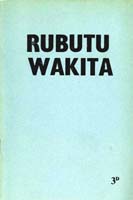
This book instructs the user in how to construct a letter and how to use the post office. The sample letters between family members, friends, and the like are interesting cultural documents from the period. Download a scan of the entire book.
Traditional Marriage and Birth Customs
 These are texts from Al’adun Aure da Haihuwa a Al’ummun Yobe [Hausa: Customs of Marriage and Birth among Yobe Peoples], a collection published in Potiskum in 2002 by the Yobe Languages Research Project. The collection comprises descriptions of marriage and birth practices among five Yobe groups: Bade, Bole, Karekare, Ngamo, and Ngizim. Click on the links below for the Bole texts with line by line English translation.
These are texts from Al’adun Aure da Haihuwa a Al’ummun Yobe [Hausa: Customs of Marriage and Birth among Yobe Peoples], a collection published in Potiskum in 2002 by the Yobe Languages Research Project. The collection comprises descriptions of marriage and birth practices among five Yobe groups: Bade, Bole, Karekare, Ngamo, and Ngizim. Click on the links below for the Bole texts with line by line English translation.
Talube Kaibono Kuyanga Bolewa [Customs of Marriage of a New Bride of the Boles]
Talube Leyi Kuyanga Bolewa [Traditional Birth Customs for a New Mother of the Boles]
DINDI KO GAMA YAKA
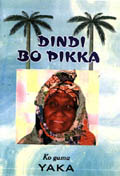 The tales here were narrated by Yaka, a well known story teller of Potiskum who is now in her 90’s. Her actual name is Amina Kakkaba. These tales were recorded in the early 1990’s by Abubakar Garba in Potiskum and transcribed by Alhaji Maina Gimba. They appear in DINDI BO PIKKA ko gama Yaka [“Tales in Bole” by Yaka], published in 2000 in Potiskum under the aegis of the Fika Development Association (FIDA). A reproduction of the cover is to the left. This is the first work of original Bole literature ever published (the only other publications in Bole being a set of adult literacy manuals from the 1950’s, seen just above on this page).
The tales here were narrated by Yaka, a well known story teller of Potiskum who is now in her 90’s. Her actual name is Amina Kakkaba. These tales were recorded in the early 1990’s by Abubakar Garba in Potiskum and transcribed by Alhaji Maina Gimba. They appear in DINDI BO PIKKA ko gama Yaka [“Tales in Bole” by Yaka], published in 2000 in Potiskum under the aegis of the Fika Development Association (FIDA). A reproduction of the cover is to the left. This is the first work of original Bole literature ever published (the only other publications in Bole being a set of adult literacy manuals from the 1950’s, seen just above on this page).
-
- Anin Koyi Godom [The Possessors of Many Heads]: A woman bears ten children, all but one being monsters with multiple heads. The trouble starts when the wife of the only “normal” one wants to visit her husband’s family.
-
- Da Mbormi [Sister Ebony]: A girl, deceived by her friends into eating all the ebony fruits she had collected, is sent by her mother back to the bush to collect more. Therein begins an adventure which ends with the girl escaping partying hyenas and delivering the fruits.
-
- An Ngondol [An Ngondol]: A child reaches four years and refuses to descend from his mother’s back. She figures out a way to get him to get on a hyena’s back, who has trouble getting rid of him.
-
- Kulti ga Zonge [A Hare and a Hyena]: A hyena takes affront when a hare makes fun of his appearance, and the hyena takes him to court.
-
- Zonge ga Ada [The Hyena and the Dog]: The hyena and the dog start by raising their families together, but as usual the greedy and not very smart hyena ends up the loser.
-
- Lawo ga Kuredi [A Girl and a Snake]: A girl refuses to marry a man with any blemishes, but when a snake transforms himself into a perfect man and she marries him, her troubles start.
-
- Ani Ndolinka ga Ani Kud’ad’i [The Well-loved Wife and the Disliked Wife]: The disliked wife is given insufficient food by her husband, but she discovers a way to get all sorts of good things at the house of Mother Death. The well-liked wife, on seeing the good things, wants some too.
-
- Manshi ga Uwwato [An Old Woman and her Goats]: An old woman with a herd of goats is intimidated into giving them one-by-one to a hyena. The lion helps her out of her difficulty (the “Magnificent Seven Minus Six”!).
-
- Ibilisa ga Da Zonge [The Devil and Zonge (“Desert Date”)]: The devil comes all dressed up and Da Zonge foolishly marries him. After he eats her sister, she decides it was a bad idea and has her family help destroy him.
-
- Memu ga Dande Oshi Kossu Kunum [A Man and Three Goat Kids]: A man discovers a goat and her three kids in the bush and brings them home. It turns out to have been a very bad idea!
-
- Zonge ga Aiki [A Hyena and a Squirrel]: A classic tale for the Yobe area, starting when a gluttonous hyena and the trickster squirrel bear gifts on a visit to the king. This version of the tale has not appeared in print.
DINDI BO PIKKA (ko gama Yagana Amma Mazawun)
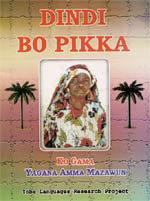 The tales in this collection were narrated by Yagana Amma Mazawun sometime in the 1990’s and recorded and transcribed by Malam Baba Ali of Potiskum, Yobe State, Nigeria. They were published in 2003 by the Yobe Languages Research Project in Potiskum (printed by Ajami Press, Potiskum).
The tales in this collection were narrated by Yagana Amma Mazawun sometime in the 1990’s and recorded and transcribed by Malam Baba Ali of Potiskum, Yobe State, Nigeria. They were published in 2003 by the Yobe Languages Research Project in Potiskum (printed by Ajami Press, Potiskum).
- Dindi Da Zonde [The Tale of Sister Zonde]: The impetuous Da Zonde marries a good-looking man who turns out to be an evil man-eating spirit in disguise. Her two sisters come to visit her, each with different outcomes.
- Dindi Am Mara [The Tale of the Farmer]: A farmer is the victim of a snake who crawls into his belly. He is given a ruse to have a heron pull the snake out, after which a series of events showing thanklessness follow.
- Dindi Ngarngaza [The Story of Ngarngaza]: A girl marries a bishop bird who turns out to be a king, who is so rich that he uses strips of meat as toilet paper on his son, Ngarngaza. This upsets the grandmother, who extracts vengeance.
- Dindi An Dasa [The Tale of the Jealous Man]: A young man vows to sleep with the wife of an overly jealous husband. When caught by the husband, the wife and the paramour manage a ruse to extract themselves.
- Dindi An Shila Ga Monduni [The Tale of a Miser and His Wife]: A man an his wife move far into the bush to avoid sharing any of their food. A young man devises a way to get food from them.
- Dindi Zonge Bonguru Bo Memu [The Tale of a Hyena that Turned into a Person]: A girl marries a handsome young man who is actually a transformed hyena. When his mother-in-law falls ill, he sings an ominous song at her doorway that the wife finds out about.
- Dindi Lawo ga Molleto Bolou [The Tale of a Girl and her Two Younger Sisters]: A girl marries a man who turns out to be a spirit. The girls from his village play a strange game. Her two sisters come to visit, but when they join in the game, the results are different.
- Dindi Kungurum Koyi [The Tale of the Skull]: A man and a woman discover a skull in their travels. The skull speaks to them and turns out to be a demanding guest. The man and woman use various schemes to try to rid themselves of him.
- Dindi Am Mara Ga Mbole [The Tale of the Farmer and the Dove]: A farmer has a dispute with a dove, who agrees to reward him for not slaughtering her. The farmer’s wives react in different ways to his interactions with the dove, with effects on his fate.
- Dindi Monde Bolou Ga Dandesu [The Story of Two Women and their Daughters]: When a co-wife dies and leaves her daughter behind, the living co-wife favors her own daughter over the orphan. The orphan cries about her problem at her mother’s grave with supernatural results.
KOMNO BO BOLEWA
collected by: Alhaji Maina Gimba, Madu Bah, Malam Baba Ali
 Komno Bo Bolewa is a collection of proverbs, riddles, tongue twisters, superstitions, and song texts assembled by Alhaji Maina Gimba, Madu Bah, and Malam Baba Ali and published by the Yobe Languages Research Project in 2004 (printed by Ajami Press, Potiskum).
Komno Bo Bolewa is a collection of proverbs, riddles, tongue twisters, superstitions, and song texts assembled by Alhaji Maina Gimba, Madu Bah, and Malam Baba Ali and published by the Yobe Languages Research Project in 2004 (printed by Ajami Press, Potiskum).
Mbosa ga Mbosa [Proverbs]: Bole with English translations and, for some, interpretative comments.
Dindi Botto-Botto [Riddles]: Bole with English translations and some interpretative comments with the answers.
Dabila Mbosa [Tongue Twisters]
Aru [Songs]
LABAR GA KOMNO BO BOLE
Malam Baba Ali, Ajiya A. Idris, Madu Bah
 This is a collection, published in 2007 by the Yobe Languages Research Project (printed by Ajami Press, Potiskum) that includes both modern and traditional elements.
This is a collection, published in 2007 by the Yobe Languages Research Project (printed by Ajami Press, Potiskum) that includes both modern and traditional elements.
- Labar Kadija Zangaya [The Story of Kadija of Zangaya], written by Malam Baba Ali: This work represents a milestone for Yobe State Languages. In Western literary terms, it would be categorized as a short story. It is the first work in original prose writing (as opposed to folk literature, oral history, description of customs, and the like) in any of the languages indigenous to Yobe State. It deals with some traditional topics, but the form and style are modern.
- Kosai Magajin Nama [Hausa: Bean Cakes, Successor of Meat], written by Ajiya A. Idris: Not exactly a folktale, this story gives the origin of the phrase “kosai magajin nama”.
- Gompo Kula [Calabash Game], written by Madu Bah: This is a description of a traditional courtship game between young people, sometimes leading to marriage.
- Dabila Mosa [Tongue Twisters], collected by Madu Bah: This adds to those already published in 2004 in Komno Bo Bolewa.
- Shampi [Superstitions/Beliefs], collected by Madu Bah. This adds to those already published in 2004 in Komno Bo Bolewa.
Aru Bo Bole
compiled by: Alhaji Maina Gimba; Malam Baba Ali; Madu Bah
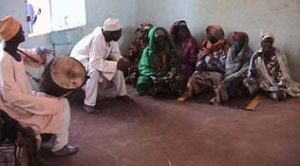 This is a collection of Bole songs with commentary on the occasions when they are sung, the background under which the songs were composed, and the meanings of selected lines. Both songs and commentary have facing English translation. Click here to download a pdf file of the book.
This is a collection of Bole songs with commentary on the occasions when they are sung, the background under which the songs were composed, and the meanings of selected lines. Both songs and commentary have facing English translation. Click here to download a pdf file of the book.
For an outsider, the content seems extremely allusive, disconnected, and hard to understand. The accompanying commentaries should help to some extent.
The contents are as follows:
ARU BO BOLE [Songs in the Bole Language]: Introduction to the book
ARU BOLE IN PIKKA [Bole Songs of Fika] (Fika is the large native Bole town in Yobe State)
Alkama Da’ande Pikka (the singer’s name)
- Ni Kina Tishi [I Can’t Eat]
- Dim bana le? [How Does it Concern Me?]
- Kona [name of a song “style”–see a full paper on Kona]
- Maji ga Maina Kura [Magaji and Maina Kura]
- Sawura Elennan Labar [A Kite Has Brought Me News]
Goro Kaka Zangaya
- Juma a Ndako [Friday is Coming]
- Bungano ye Bunga ga Wara [My Boyfriend is a Young Man in Wara]
- Zabiya Jergete [Zabiya Jergete]
- Aru Durshe [Grinding Song]
Ya Maryama Pikka
- Lawo Ar Rawu [A Girl Who Braids]
- Kona [name of a song “style”–see a full paper on Kona]
Goro Maryo Guduwi
- Yarima d’an Sarki [Yarima son of Sarki]
Yakura Iya Zangaya
- Aru Osso ga in Jakkutu [Songs for Grinding and for Jakkutu (a type of dance)]
Yagana Aba
- Kona [name of a song “style”–see a full paper on Kona]
- Awwa Ya Gana [a woman’s name]
Hajja Fatume Ciroma
- Ba Ka I Dara Yawi [If You Make Your Wealth with Chickens]
- Da Dingi Dingi [Da Dingi Dingi]
- Janna ga Kad’i [Paradise Outside]
- Ni Wani Sa [I Didn’t Get Him]
ARU BOLE IN NGARA [Bole Songs from Ngara] (Ngara is a town on the Gongola River, the southern boundary of Yobe State; the dialect is slightly different from that of Fika)
Yagana Daso Ngara
- Ni Nguru Ati Pullu [I Have Become an Object of Abuse]
- Porantun Sunno [They Spoke My Name]
- Bano Ndi ga Garu [My Elder Brother Has Gone to the City]
GOMPO DANDE [Children’s Games]
- Baba Ai Bono [Daddy, Oh My Father]
- In Towwani In Towwani Sa [Should I Praise Him, Should I not Praise Him]
- Baya Da Jija [Slave Sister Dija]
- Lelo ga Njonnini [Everyone Has His Twin]
- Gompo Duji [Game of the Owl]
- Borom Aiki [Escape Hole of the Squirrel]
Stories and Texts from Fika Secondary School
The texts here were written in Bole by third year students at the Fika Boys Secondary School.
Labar Kushi Gando ga Ko Gusho Danissi (Daniski) [The Story of the Reclining Baobab on Daniski Hill], written by Ado Madu: This is a version of the well-known legend of a baobab tree on Daniski Hill, the traditional original settlement site of the Bole people in this area, which would at times recline and at other times become erect. The site was viewed as miraculous and became a place of pilgrimage.
Zonge ga Aiki [The Hyena and the Squirrel], written by Mustapha Hassan: Another tale in which the squirrel tricks the hyena, this time to get some food from a trap.
Narratives and Conversations in Bole
by various storytellers
 These are miscellaneous stories and other narratives collected by Alhaji Maina Gimba and Russell Schuh in Yobe State between 2000 and 2009. Click on the links to download PDF files with English translation.
These are miscellaneous stories and other narratives collected by Alhaji Maina Gimba and Russell Schuh in Yobe State between 2000 and 2009. Click on the links to download PDF files with English translation.
Tales
Memu Mod’i ga Monduni [A Man and His Wife], narrated by Ladi Adamu Dala in Fika, August 10, 2000.
Maina ga Yadikkoni ga Moleni [A Prince, his Stepmother, and his Little Sister], narrated by Abubakar Ba’aba Kalli in Fika, August 10, 2000.
Conversations
Kele Bo Pikka [Greeting in Bole]: Two men meeting in the street, greeting each other, and discussing various matters such as their farms and highway robbers. The conversation is 3:45 long and the video is 17.6 MB. Video of the conversation available on request from schuh@humnet.ucla.edu.
Lawo Masidi [The Mosque Girl]: A short conversation in Bole with some children outside the main mosque in Fika. The link opens a page with the video and a link to the transcript.
Bani Ajiyan Goru [Compound of the District Head]: Videotaped in 2000 in Potiskum, this is a tour through a traditional large family compound, in this case, the compound of the late Alhaji Sulaiman Gimba, District Head (Ajiyain Bole, Hakimi in Hausa) of Potiskum.
Aru Bo Pikka [Poetry and Song in Bole]
Kona
Kona is a song “style” associated with certain sung verses, a rhythmic pattern, and a dance. The discussion here is based on six performances of the kona song by five different singers, all women in Potiskum and Fika, Nigeria.
- Yagana Aba: Audio recording of a capella solo performance made by Alhaji Maina Gimba in Potiskum, early 1990’s.
- Alkama Anna: Audio recording of a capella solo performance made by Alhaji Maina Gimba in Potiskum, early 1990’s.
- Unidentified singer: Audio recording of a capella solo performance made by Alhaji Maina Gimba in Potiskum, early 1990’s.
- Yagana Aba: Video recording of a capella solo performance made by Russell Schuh and Alhaji Maina Gimba in Potiskum, August 3, 2000
- Hajja Adde: Video recording of a capella soloperformance made by Russell Schuh and Alhaji Maina Gimba in Potiskum, August 3, 2000
- Zabiya Baba Data: Video and audio recording of performance with drums and dancing made by Russell Schuh and Alhaji Maina Gimba in Fika, August 22, 2000.

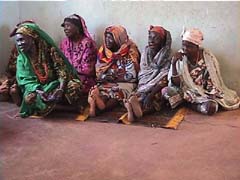
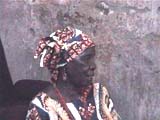
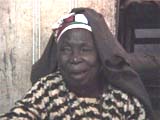

Several of the versions of kona start with a verse something like, Na kona wonta did’o Tandu Adama ‘They say kona is movement of the neck, Tandu Adama’, suggesting the type of movement involved in the dance. The song is not always easy to interpret, but the main theme is adultry and dalliance, and the recurrent “protagonist” is Disa be Kawuwa ‘Disa son of Kawuwa’, who ends up being caught with another man’s wife (see verse 13 in the sample verses below). Here are some sample verses from the song as sung by Alkama Anna:
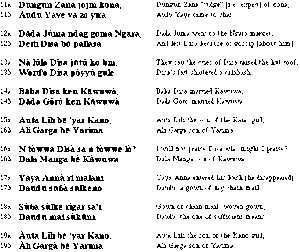
Listen to these verses by playing the movie “Kona (selected verses)”:
kona_alkama.mov
As this sample shows, the kona song is divided into two-line verses. In all our recorded versions, women singing alone sing one verse right after the other. In the video with drum accompaniment, the solo singer sings a verse, then the chorus of women “answer”.
As in most African music, there is no rhyme, but there is a basic metrical or rhythmic pattern that the text of each line follows. Syllables in Bole are either “heavy” or “light”. Heavy syllables consist of C + long vowel or CVC, light syllables consist of C + short vowel (C = any consonant, V = any vowel). The most common rhythmic pattern for kona lines is as follows, using line 14a above as an example line. A doubled vowel here shows a long vowel, — = heavy syllable, v = light syllable. The last syllable in a line is rhythmically heavy, even if it is actually light.
— v — v — — v —
Baa-ba Dii-sa bee Kaa-wu-wa
For a more extended discussion of kona and metrics, click on the link below for a 22 page paper in PDF format. “The Metrics of a Bole Song Style, Kona” by Russell G. Schuh
Bole-English-Hausa Dictionary
Alhaji Maina Gimba; Madu Bah; Malam Baba Ali
In 2004, the Yobe Languages Research Project produced the first Bole-English-Hausa Dictionary, published by Ajami Press, Potiskum, Nigeria. In addition to an introduction that includes background on the dictionary, explanations of dictionary layout, acknowlegdments, and abbreviations, there are three main sections: Bole-English-Hausa Dictionary, English-Bole Wordlist, and Hausa-Bole Wordlist. The Bole-English-Hausa section has about 3900 head entries (excluding pronunciation variants of the same words). The English-Bole and Hausa-Bole sections are really just indexes to the Bole-English-Hausa section, i.e. no attempt was made to compile comprehensive lists of English or Hausa words and seek Bole equivalents. Below are sample entries from each section. The full dictionary can be downloaded as a PDF file.
Bole-English-Hausa
|
English-Bole
Hausa-Bole
|
Papers and Other Works on Bole
The references cited on this page contain information on the Bole language or contain data of interest for the study of the Bole language. Some of these works (those with highlighted titles) can be downloaded as PDF files, and over time, others will be made available.
See Aliyu (1996) and Ibriszimow (1996) for additional references that are primarily historical or ethnographic.
Various Authors
Bole has been the subject of various studies since the early 20th century. Listed here are most of the works that have concentrated on Bole language and/or have substantial information on the Bole language other than works by Russell Schuh and Alhaji Maina Gimba. Follow the links at the top of the page for works by these two. PDF files of the papers with highlighted links can be downloaded.
- Abraham, R.C. 1929. “The Bolanci language and the conclusions to be drawn from it.” File No. K.119. Kaduna Archives. [Fairly extensive wordlist, grammatical remarks, and comparative remarks on “the Hausa-Bolanchi-Angass group”.]
- Aliyu, Musa Masaya. 1996. “An introduction to the history of Fika Emirate–1903-1940.” In Ibriszimow, Dymitr (ed.), 1996, pages 169-229.
- Awad, Maher. 1996. “On the function of the complementizer na in Bolanci.” Linguistique Africaine 17:5-26.
- Benton, P.A. 1968 [1912]. “Notes on Bolanchi.” In The Languages and Peoples of Bornu, being a collection of the writings of P.A. Benton, with an Introduction by A.H.M. Kirk-Greene, vol. I, Notes on some Languages of the Western Sudan, pp. 1-37. London: Frank Cass.
- Heinrich, Jürgen. 1994. “Landscape development and environmental change in northern parts of the Gongola Basin, northeastern Nigeria.” In Ibriszimow, Dymitr and Alhaji Maina Gimba (eds.), 1994, pages 49-67.
- Ibriszimow, Dymitr and Alhaji Maina Gimba (eds.). 1994. Bole Language and Documentation Unit, BOLDU, Report I. Köln: Rüdiger Köppe Verlag.
- Ibriszimow, Dymitr and Alhaji Maina Gimba. 1994. “Crafts”. In Ibriszimow, Dymitr and Alhaji Maina Gimba (eds.), 1994, pages 15-45. [Description of kumba tray, mat plaiting, and calabash decoration.]
- Ibriszimow, Dymitr and Alhaji Maina Gimba. 1994. “Toponyms.” In Ibriszimow, Dymitr and Alhaji Maina Gimba (eds.), 1994, pages 85-100.
- Ibriszimow, Dymitr and Alhaji Maina Gimba. 1994. “Glossary, Bole-English.” In Ibriszimow, Dymitr and Alhaji Maina Gimba (eds.), 1994, pages 125-137. [List of Bole terms in Ibriszimow, Dymitr and Alhaji Maina Gimba (eds.). 1994.]
- Ibriszimow, Dymitr (ed.). 1996. Bole Language and Documentation Unit, BOLDU, Report II. Köln: Rüdiger Köppe Verlag.
- Ibriszimow, Dymitr. 1996. “Girgam–the history of the Bole (Fika) People.” In Ibriszimow, Dymitr (ed.), 1996, pages 13-154.
- Kauka, Rupert. 1994. “A survey on migration from Fika, northeastern Nigeria.” In Ibriszimow, Dymitr and Alhaji Maina Gimba (eds.), 1994, pages 69-84.
- Koelle, Sigismund W. 1854 [1963]. Polyglotta Africana. London: CMH. Reprinted 1963, Graz, Austria: Akademischen Druk–u. Verlagsanstalt, with a historical introduction by P.E.H. Hair. [Listed as VII.B.1, “Pika”.]
- Kraft, Charles H. 1981. Chadic Word Lists, Volume 1. Marburger Studien zur Afrika- und Asienkunde, Serie A: Afrika Band 23, vol. 1. Berlin: Dietrich Reimer. [List from the Gombe dialect.]
- Lavers, John E. 1992. “R.C. Abraham: the Bolewa and Bolanci.” In Philip J. Jaggar (ed.), Papers in Honour of R.C. Abraham (1890-1963), pp. 29-36. African Languages and Cultures, Supplement I. London: SOAS.
- Lukas, Johannes. 1966. “Tschadohamitische Sprachproben aus Nordnigerien.” Neue Afrikanistische Studien, pp. 173-189. Hamburger Beiträge zur Afrika-Kunde, Band 5. Hamburg: Deutsches Institute für Afrika-Forschung.
- Lukas, Johannes. 1969. “Tonpermeable und Tonimpermeable Konsonanten im Bolanci (Nordnigerien).” In Ethnological and Linguistic Studies in Honour of N. J. van Warmelo, Ethnological Publications No. 52, pp. 133-138. Pretoria:Government Printer.
- Lukas, Johannes. 1970-72. “Die Personalia und das primäre Verb im Bolanci (Nordnigerien).” Afrika und Übersee 54:237-286, 55:114-139.
- Lukas, Johannes. 1971. “Über das erweiterte Verb im Bolanci (Nordnigerien).” Journal of African Languages. 10(1):1-14.
- Meek, C.K. 1931. “Some tribes of Bornu Province: The Bolewa of Fika.” Tribal Studies in Northern Nigeria, Volume 2, pp.288-310. London: Kegan Paul.
- Seidensticker-Brikay, Gisela and Wilhelm Seidensticker. 1994. “Guide to Potiskum museum with catalogue of artefacts.” In Ibriszimow, Dymitr and Alhaji Maina Gimba (eds.), 1994, pages 101-124.
Works by Alhaji Maina Gimba
The following are works by Alhaji Maina Gimba as sole authors. See also works above co-authored by Ibriszimow and Gimba and below by Schuh and Gimba.
- Gimba, Alhaji Maina. undated. “Aspects of brevity in the dialects of Bole.” Manuscript, Department of English, University of Maiduguri.
- Gimba, Alhaji Maina. 1986. “A contrastive analysis of English and Bole phonology.” BA dissertation, Faculty of Arts and Islamic Studies, Bayero University, Kano.
- Gimba, Alhaji Maina. 1990. “A study of the Bole dialects.” MA thesis, Bayero University, Kano. [The manuscript from which the PDF was made is very light, and the file is hard to read. OCR text recognition was applied but it recognized very little of the text. This might be improvable. If we get enough requests for this work, we may try again.]
- Gimba, Alhaji Maina. 1998. “Low Tone Raising in Bole.” MA thesis, UCLA Department of Linguistics.
- Gimba, Alhaji Maina. 2000. “Bole verb morphology.” PhD dissertation, UCLA Department of Linguistcs.
- Gimba, Alhaji Maina. 2001. “Verbal pluractionality in Bole.” In Harold Torrence (ed.), Papers in African Linguistics 1, pp. 158-171. UCLA Working Papers in Linguistics 6. Los Angeles: UCLA Department of Linguistics.
Works by Russel G. Schuh and Joint Work with Alhaji Gimba
Russell Schuh began field research on Bole in 1982 and began collaborating with Alhaji Maina Gimba in 1995. See above for work by Gimba as sole author.
- Schuh, Russell G. 1983. “The Bolanci verbal system.” Manuscript, Ahmadu Bello University and UCLA. [Description of the verbal system of the Gadaka dialect of Bole.]
- Schuh, Russell G. undated. “Bolanci genitives with remarks on underlying contour tones and tone sequences.” Paper originally written for Current Perfectives in African Linguistics in honour of Professor Ayo Bamgbose, a volume which seems to have not been published and is probably defunct.
- Schuh, Russell G. and Alhaji Maina Gimba. 2001. “Substantive and anaphoric ‘thing’ in Bole, with remarks on Hausa ‘abu/abin’.” In Harold Torrence (ed.), Papers in African Linguistics 1, pp. 90-122. UCLA Working Papers in Linguistics 6. Los Angeles: UCLA Department of Linguistics.
- Schuh, Russell G. 2001. “Sources of gemination and gemination as a morpheme in Bole.” Paper presented as a plenary paper at the 32nd Annual Conference on African Linguistics, UC Berkeley, March 2001.
- Schuh, Russell G. 2001. “The Metrics of a Bole Song Style, Kona.“ Ms. UCLA. This is a description of cultural context, performance, and metrics of a traditional song.
- Schuh, Russell G., Alhaji Maina Gimba, and Amanda Ritchart. 2010. “Bole intonation.” UCLA Working Papers in Phonetics, No. 108, pp. 226-248.
- Schuh, Russell G. 2013. “Metrics of Bole songs.” Paper presented at the 7th Biennial International Colloquium on Chadic Languages, Hamburg, 12-14 September 2013.



